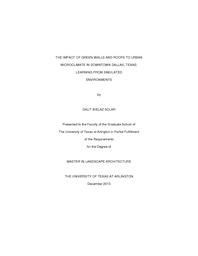| dc.description.abstract | Microclimate refers to a localized zone where the climate is different than the surrounding area. In dense urban areas, climate is affected by "urban thermo-physical and geometrical characteristics, anthropogenic activities and heat sources" (Dimoudi et.al. 2013, p.1). Materials such as brick, asphalt, and concrete absorb the sun's energy, and then heat-up, and re-radiate that heat into the ambient air, creating urban heat island effects. These effects can be partially mitigated by modifying the physical surface and mass properties of buildings. By adding vegetation and soil, in addition to the shade made by surrounding buildings, seasonal energy gain may be modified. Green walls and roofs help the reduction of the urban heat island effects, improve air quality, and storm-water runoff (Greenscreen, 2012; Cantor, 2008). According to the National Weather Service, Dallas, Texas has an average high winter temperature of sixty-one degrees Fahrenheit and, an average high summer temperature of ninety-six degrees Fahrenheit (NOAA, 2012; Winguth and Kelp, 2013). Studies indicate that the urban heat island effect can increase the temperature six to eight degrees Fahrenheit (HARC and EPA, 2009) and create a warmer microclimate in the downtown area. The Leadership in Energy and Environmental Design (LEED) encourages the use of green walls and roof systems to reduce microclimates created by infrastructures and buildings (USBG, 2013). Although there are a few buildings in the Downtown Dallas area that have employed green façades and roofs little is known about the impact of green façades and roofs on microclimate.The purpose of this research is to study the impact of green walls and roofs on urban heat island effect in urban areas. This research studies downtown microclimate and uses downtown Dallas, Texas models as a lab to test and illustrate the potential of green walls and roofs on urban heath island effects impacting urbanized areas. Research specifically focuses on seasonal wind patterns and solar exposure simulations at various scales, from a single building to a district, to understand and visualize such impacts. This study focuses on the impact of green walls and roofs in a section of the central business district of Dallas, Texas. It studies locations to understand the effects of green walls and roofs aimed by simulated experiments. Two physical models were created to simulate a portion of Downtown Dallas. Sun and air movement studies were conducted on the models. Planar Laser Induced Fluorescence (PLIF), Water Flume Table, and Heliodon experimental techniques were used to study and visualize a range of scenarios (McDermott et al., 2013). Outcomes are documented photographically and data are compared through the photographs with the before and after scenarios. Wind and sun studies show that when placing green walls and roofs, buildings are protected and the effects of the wind and sun radiation are lessened. Simulations suggest the application and appropriate placement of features like green walls and roofs can influence microclimate and help reduce the urban heat island effects in the case of Dallas, Texas. | en_US |


